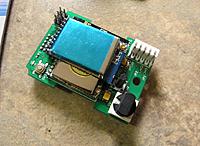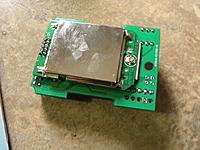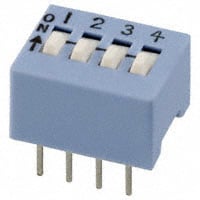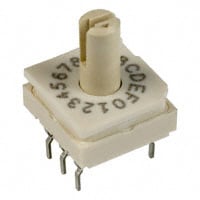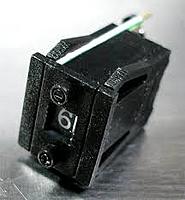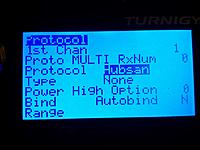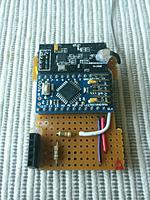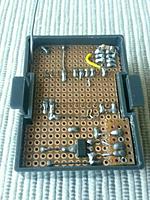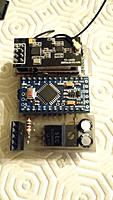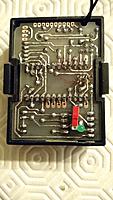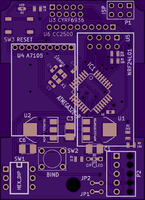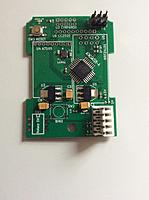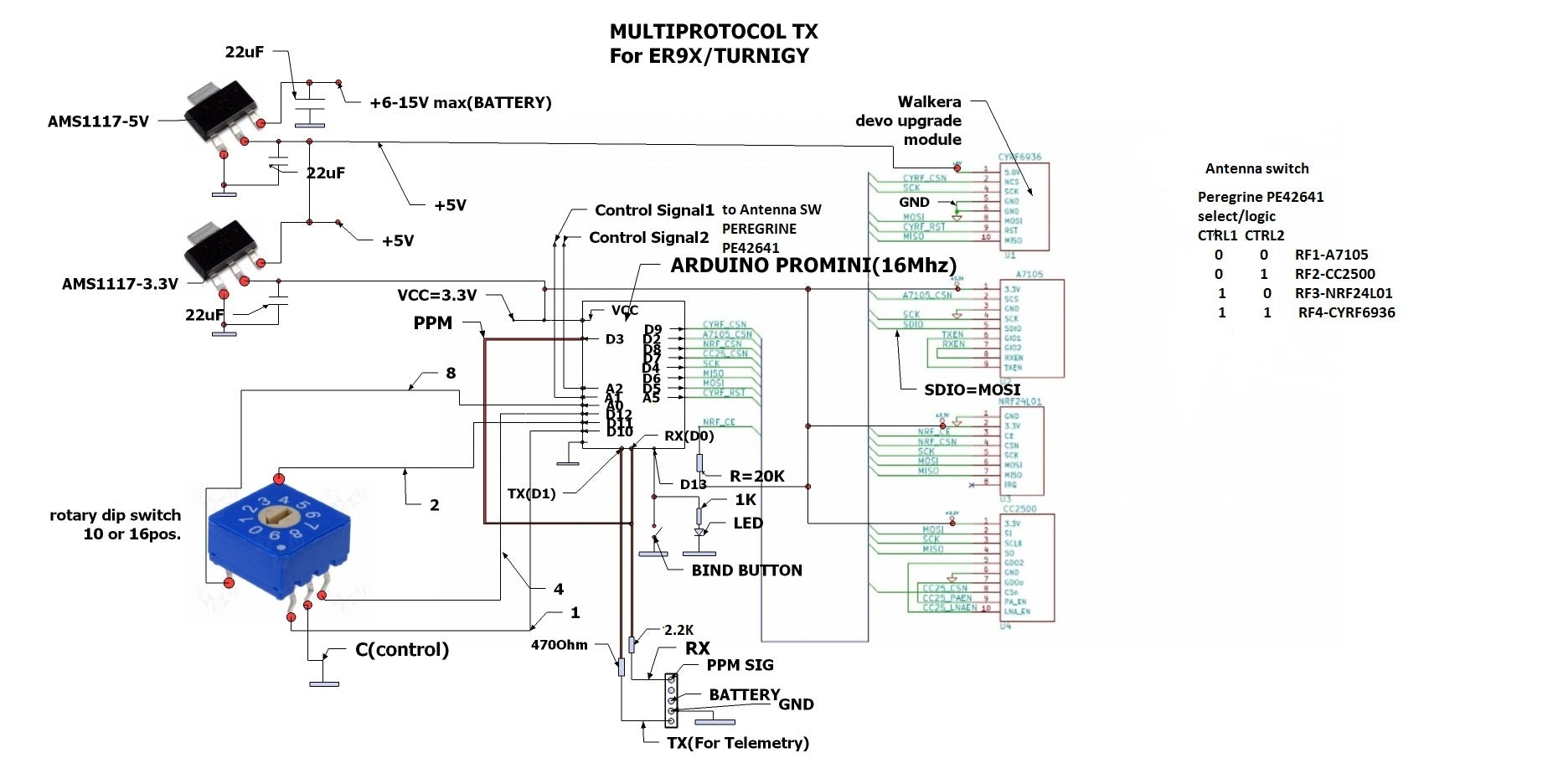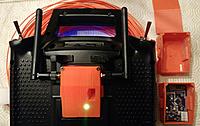DIY-Multiprotocol-TX-Module
Multiprotocol is a 2.4GHz transmitter which enables any TX to control lot of different models available on the market.
The source code is partly based on the Deviation TX project, thanks to all the developpers for their great job on protocols.
Forum link on RCGROUPS for additional information or requesting a new protocol integration.
To download the latest compiled version (hex file), click on Release on the top menu.
##Contents
##Compatible TX
###Using standard PPM output (trainer port) The multiprotocol TX module can be used on any TX with a trainer port.
Channels order is AETR by default but can be changed in the _Config.h.
The protocol selection is done via a dip switch, rotary dip switch or scsi ID selector.
You can access to up to 15 different protocols and associated settings.
Settings per selection are located in _Config.h:
- Protocol and type: many main protocols have variants
- RX Num: number your different RXs and make sure only one model will react to the commands
- Power: High or low, enables to lower the power setting of your TX (indoor for example).
- Option: -127..+127 allowing to set specific protocol options. Like for Hubsan to set the video frequency.
- Autobind: Yes or No. At the model selection (or power applied to the TX) a bind sequence will be initiated
###Using a serial output The multiprotocol TX module takes full advantage of being used on a Turnigy 9X, 9XR, 9XR Pro, Taranis, 9Xtreme, AR9X, ... running er9x or ersky9X. (A version for OpenTX is being looked at)
This enables full integration using the radio GUI to setup models with all the available protocols options.
Options are:
- Protocol and type: many main protocols have variants
- RX Num: number your different RXs and make sure only one model will react to the commands
- Power: High or low, enables to lower the power setting of your TX (indoor for example).
- Option: -127..+127 allowing to set specific protocol options. Like for Hubsan to set the video frequency.
- Bind: bind a RX/model
- Autobind: Yes or No. At the model selection (or power applied to the TX) a bind sequence will be initiated
- Range: test range by setting the transmission power to the lowest value
Notes:
- Using this solution does not need any modification of the TX since it uses the TX module slot PPM pin for serial transfer.
- There are 2 versions of serial protocol either 8 or 16 channels. 16 channels is the latest and only available version going forward. Make sure to use the right version based on your version of er9x/ersky9x.
- Channels order is AETR by default but can be changed in _Config.h.
###Telemetry
There are 3 protocols supporting telemetry: Hubsan, FrSky and FrSkyX.
Hubsan displays the battery voltage and TX RSSI.
FrSky displays full telemetry (A0, A1, RX RSSI, TX RSSI and Hub).
FrSkyX displays basic telemetry (A1, A2 and RX RSSI).
If used in PPM mode
Telemetry is available as a serial 9600 8 n 1 output on the TX pin of the Atmega328p using the FRSky hub format.
You can connect it to your TX if it is telemetry enabled or use a bluetooth adapter (HC05/HC06) along with an app on your phone/tablet (app example) to display telemetry information and setup alerts.
If used in Serial mode
Telemetry is built in for er9x and ersky9x TXs.
To enable telemetry on a Turnigy 9X or 9XR you need to modify your TX following one of the Frsky mod like this one.
Enabling telemetry on a 9XR PRO and may be other TXs does not require any hardware modifications. The additional required serial pin is already available on the TX back module pins.
Once the TX is telemetry enabled, it just needs to be configured on the model (see er9x/ersky9x documentation).
##Protocols
###TX ID The multiprotocol TX module is using a 32bits ID generated randomly at first power up. This global ID is used by all protocols. There are little chances to get a duplicated ID.
It's possible to generate a new ID using bind button on the Hubsan protocol during power up.
###Bind To bind a model in PPM Mode press the physical bind button, apply power and then release.
In Serial Mode you have 2 options:
- use the GUI, access the model protocol page and long press on Bind. This operation can be done at anytime.
- press the physical bind button, apply power and then release. It will request a bind of the first loaded model protocol.
Notes:
- the physical bind button is only effective at power up. Pressing the button later has no effects.
- a bind in progress is indicated by the LED fast blinking. Make sure to bind during this period.
###Protocol selection
####Using the dial for PPM input PPM is only allowing access to a subset of existing protocols. The protocols, subprotocols and all other settings can be personalized by modifying the _Config.h file.
The default association dial position / protocol in every release is listed below.
| Dial | Protocol | Sub_protocol | RX Num | Power | Auto Bind | Option | RF Module |
|---|---|---|---|---|---|---|---|
| 0 | Select serial | ||||||
| 1 | FLYSKY | Flysky | 0 | High | No | 0 | A7105 |
| 2 | HUBSAN | - | 0 | High | No | 0 | A7105 |
| 3 | FRSKY | - | 0 | High | No | -41 | CC2500 |
| 4 | HISKY | Hisky | 0 | High | No | 0 | NRF24L01 |
| 5 | V2X2 | - | 0 | High | No | 0 | NRF24L01 |
| 6 | DSM2 | DSM2 | 0 | High | No | 0 | CYRF6936 |
| 7 | DEVO | - | 0 | High | No | 0 | CYRF6936 |
| 8 | YD717 | YD717 | 0 | High | No | 0 | NRF24L01 |
| 9 | KN | WLTOYS | 0 | High | No | 0 | NRF24L01 |
| 10 | SYMAX | SYMAX | 0 | High | No | 0 | NRF24L01 |
| 11 | SLT | - | 0 | High | No | 0 | NRF24L01 |
| 12 | CX10 | BLUE | 0 | High | No | 0 | NRF24L01 |
| 13 | CG023 | CG023 | 0 | High | No | 0 | NRF24L01 |
| 14 | BAYANG | - | 0 | High | No | 0 | NRF24L01 |
| 15 | SYMAX | SYMAX5C | 0 | High | No | 0 | NRF24L01 |
Note:
- The dial selection must be done before the power is applied.
####Using serial input with er9x/ersky9x Serial is allowing access to all existing protocols & sub_protocols listed below.
| Protocol | Sub_protocol | RF Module |
|---|---|---|
| Flysky | A7105 | |
| Flysky | ||
| V9x9 | ||
| V6x6 | ||
| V912 | ||
| Hubsan | A7105 | |
| Frsky | CC2500 | |
| Hisky | NRF24L01 | |
| Hisky | ||
| HK310 | ||
| V2x2 | NRF24L01 | |
| DSM2 | CYRF6936 | |
| DSM2 | ||
| DSMX | ||
| Devo | CYRF6936 | |
| YD717 | NRF24L01 | |
| YD717 | ||
| SKYWLKR | ||
| SYMAX4 | ||
| XINXUN | ||
| NIHUI | ||
| KN | NRF24L01 | |
| WLTOYS | ||
| FEILUN | ||
| SymaX | NRF24L01 | |
| SYMAX | ||
| SYMAX5C | ||
| SLT | NRF24L01 | |
| CX10 | NRF24L01 | |
| GREEN | ||
| BLUE | ||
| DM007 | ||
| Q282 | ||
| JC3015_1 | ||
| JC3015_2 | ||
| MK33041 | ||
| Q242 | ||
| CG023 | NRF24L01 | |
| CG023 | ||
| YD829 | ||
| H8_3D | ||
| Bayang | NRF24L01 | |
| FrskyX | CC2500 | |
| ESky | NRF24L01 | |
| MT99XX | NRF24L01 | |
| MT | ||
| H7 | ||
| YZ | ||
| MJXQ | NRF24L01 | |
| WLH08 | ||
| X600 | ||
| X800 | ||
| H26D |
Note:
- The dial should be set to 0 for serial. Which means all protocol selection pins should be left unconnected.
###Protocol details Extended limits supported: -125%..+125% can be used and will be transmitted. Otherwise the default is -100%..+100% only.
Autobind protocol: you do not need to press the bind button at power up to bind, this is done automatically.
####BAYANG Models: EAchine H8(C) mini, BayangToys X6/X7/X9, JJRC JJ850, Floureon H101 ...
Autobind protocol
| CH1 | CH2 | CH3 | CH4 | CH5 | CH6 | CH7 | CH8 | CH9 | CH10 |
|---|---|---|---|---|---|---|---|---|---|
| A | E | T | R | FLIP | RTH | PICTURE | VIDEO | HEADLESS | INVERTED |
####CG023 Models: EAchine CG023/CG031/3D X4
Autobind protocol
| CH1 | CH2 | CH3 | CH4 | CH5 | CH6 | CH7 | CH8 | CH9 |
|---|---|---|---|---|---|---|---|---|
| A | E | T | R | FLIP | LIGHT | PICTURE | VIDEO | HEADLESS |
#####Sub_protocol YD829 Models: Attop YD-822/YD-829/YD-829C ...
| CH5 | CH6 | CH7 | CH8 | CH9 |
|---|---|---|---|---|
| FLIP | PICTURE | VIDEO | HEADLESS |
#####Sub_protocol H8_3D Models: EAchine H8 mini 3D, JJRC H20/H22
| CH5 | CH6 | CH7 | CH8 | CH9 |
|---|---|---|---|---|
| FLIP | LIGTH | OPT1 | OPT2 | CAL |
JJRC H20: OPT1=Headless, OPT2=RTH
JJRC H22: OPT1=RTH, OPT2=180/360° flip mode
H8 3D: OPT1=RTH + headless, OPT2=180/360° flip mode
CAL: calibrate accelerometers
####CX10 Extended limits supported
Autobind protocol
| CH1 | CH2 | CH3 | CH4 | CH5 | CH6 |
|---|---|---|---|---|---|
| A | E | T | R | FLIP | RATE |
Rate: -100%=rate 1, 0%=rate 2, +100%=rate 3
#####Sub_protocol GREEN Models: Cheerson CX-10 green pcb
Same channels assignement as above.
#####Sub_protocol BLUE Models: Cheerson CX-10 blue pcb & some newer red pcb, CX-10A, CX-10C, CX11, CX12, Floureon FX10, JJRC DHD D1
| CH5 | CH6 | CH7 | CH8 |
|---|---|---|---|
| FLIP | RATE | PICTURE | VIDEO |
Rate: -100%=rate 1, 0%=rate 2, +100%=rate 3 or headless for CX-10A
#####Sub_protocol DM007
| CH5 | CH6 | CH7 | CH8 | CH9 |
|---|---|---|---|---|
| FLIP | MODE | PICTURE | VIDEO | HEADLESS |
#####Sub_protocol Q282 and Q242
| CH5 | CH6 | CH7 | CH8 | CH9 | CH10 | CH11 | CH12 |
|---|---|---|---|---|---|---|---|
| FLIP | LED | PICTURE | VIDEO | HEADLESS | RTH | XCAL | YCAL |
Model: JXD 509 is using Q282 with CH12=Start/Stop motors
#####Sub_protocol JC3015_1
| CH5 | CH6 | CH7 | CH8 |
|---|---|---|---|
| FLIP | MODE | PICTURE | VIDEO |
#####Sub_protocol JC3015_2
| CH5 | CH6 | CH7 | CH8 |
|---|---|---|---|
| FLIP | MODE | LED | DFLIP |
#####Sub_protocol MK33041
| CH5 | CH6 | CH7 | CH8 | CH9 | CH10 |
|---|---|---|---|---|---|
| FLIP | MODE | PICTURE | VIDEO | HEADLESS | RTH |
####DEVO Extended limits supported
| CH1 | CH2 | CH3 | CH4 | CH5 | CH6 | CH7 | CH8 |
|---|---|---|---|---|---|---|---|
| CH1 | CH2 | CH3 | CH4 | CH5 | CH6 | CH7 | CH8 |
####DSM2 Extended limits supported
| CH1 | CH2 | CH3 | CH4 | CH5 | CH6 | CH7 | CH8 |
|---|---|---|---|---|---|---|---|
| A | E | T | R | CH5 | CH6 | CH7 | CH8 |
####ESKY
| CH1 | CH2 | CH3 | CH4 | CH5 | CH6 |
|---|---|---|---|---|---|
| A | E | T | R | GYRO | PITCH |
####FLYSKY Extended limits supported
| CH1 | CH2 | CH3 | CH4 | CH5 | CH6 | CH7 | CH8 |
|---|---|---|---|---|---|---|---|
| A | E | T | R | CH5 | CH6 | CH7 | CH8 |
#####Sub_protocol V9X9
| CH5 | CH6 | CH7 | CH8 |
|---|---|---|---|
| FLIP | LIGHT | PICTURE | VIDEO |
#####Sub_protocol V6X6
| CH5 | CH6 | CH7 | CH8 | CH9 | CH10 | CH11 | CH12 |
|---|---|---|---|---|---|---|---|
| FLIP | LIGHT | PICTURE | VIDEO | HEADLESS | RTH | XCAL | YCAL |
#####Sub_protocol V912
| CH5 | CH6 |
|---|---|
| BTMBTN | TOPBTN |
####FRSKY Extended limits supported
Telemetry enabled for A0, A1, RSSI, TSSI and Hub
Option=fine frequency tuning, usually 0 or -41 based on the manufacturer boards
| CH1 | CH2 | CH3 | CH4 | CH5 | CH6 | CH7 | CH8 |
|---|---|---|---|---|---|---|---|
| CH1 | CH2 | CH3 | CH4 | CH5 | CH6 | CH7 | CH8 |
####FRSKYX Models: FrSky receivers X4R, X6R and X8R.
Extended limits supported
Telemetry enabled for A1 (RxBatt), A2, RSSI
Option=fine frequency tuning, usually 0 or -41 based on the manufacturer boards
| CH1 | CH2 | CH3 | CH4 | CH5 | CH6 | CH7 | CH8 | CH9 | CH10 | CH11 | CH12 | CH13 | CH14 | CH15 | CH16 |
|---|---|---|---|---|---|---|---|---|---|---|---|---|---|---|---|
| CH1 | CH2 | CH3 | CH4 | CH5 | CH6 | CH7 | CH8 | CH9 | CH10 | CH11 | CH12 | CH13 | CH14 | CH15 | CH16 |
####HISKY
| CH1 | CH2 | CH3 | CH4 | CH5 | CH6 | CH7 | CH8 |
|---|---|---|---|---|---|---|---|
| A | E | T | R | GEAR | PITCH | GYRO | CH8 |
GYRO: -100%=6G, +100%=3G
#####HK310 Models: RX HK-3000, HK3100 and XY3000 (TX are HK-300, HK-310 and TL-3C)
| CH1 | CH2 | CH3 | CH4 | CH5 | CH6 | CH7 | CH8 |
|---|---|---|---|---|---|---|---|
| T | R | AUX | T_FSAFE | R_FSAFE | AUX_FSAFE |
####HUBSAN Models: Hubsan H102D, H107/L/C/D and Hubsan H107P/C+/D+
Autobind protocol
Telemetry enabled for battery voltage and TX RSSI
Option=vTX frequency (H107D) 5645 - 5900 MHz
| CH1 | CH2 | CH3 | CH4 | CH5 | CH6 | CH7 | CH8 | CH9 |
|---|---|---|---|---|---|---|---|---|
| A | E | T | R | FLIP | LIGHT | PICTURE | VIDEO | HEADLESS |
####KN
| CH1 | CH2 | CH3 | CH4 | CH5 | CH6 | CH7 | CH8 | CH9 | CH10 | CH11 |
|---|---|---|---|---|---|---|---|---|---|---|
| A | E | T | R | DR | THOLD | IDLEUP | GYRO | Ttrim | Atrim | Etrim |
Dual Rate: +100%=full range, Throttle Hold: +100%=hold, Idle Up: +100%=3D, GYRO: -100%=6G, +100%=3G
#####Sub_protocol WLTOYS #####Sub_protocol FEILUN Same channels assignement as above.
####MJXQ Autobind protocol
| CH1 | CH2 | CH3 | CH4 | CH5 | CH6 | CH7 | CH8 | CH9 | CH10 | CH11 | CH12 | CH13 |
|---|---|---|---|---|---|---|---|---|---|---|---|---|
| A | E | T | R | FLIP | LED | PICTURE | VIDEO | HEADLESS | RTH | AUTOFLIP | PAN | TILT |
#####Sub_protocol WLH08 #####Sub_protocol X600 #####Sub_protocol X800 #####Sub_protocol H26D
####MT99XX Autobind protocol
| CH1 | CH2 | CH3 | CH4 | CH5 | CH6 | CH7 | CH8 | CH9 |
|---|---|---|---|---|---|---|---|---|
| A | E | T | R | FLIP | LED | PICTURE | VIDEO | HEADLESS |
#####Sub_protocol MT Models: MT99xx #####Sub_protocol H7 Models: Eachine H7 #####Sub_protocol YZ Models: Yi Zhan i6S Only one model can be flown at the same time since the ID is hardcoded.
####SLT Autobind protocol
| CH1 | CH2 | CH3 | CH4 | CH5 | CH6 |
|---|---|---|---|---|---|
| A | E | T | R | GEAR | PITCH |
####Symax Autobind protocol
| CH1 | CH2 | CH3 | CH4 | CH5 | CH6 | CH7 | CH8 | CH9 |
|---|---|---|---|---|---|---|---|---|
| A | E | T | R | FLIP | PICTURE | VIDEO | HEADLESS |
#####Sub_protocol SYMAX Models: Syma X5C-1/X11/X11C/X12
#####Sub_protocol SYMAX5C Model: Syma X5C (original) and X2
####V2X2 Models: WLToys V202/252/272, JXD 385/388, JJRC H6C, Yizhan Tarantula X6 ...
| CH1 | CH2 | CH3 | CH4 | CH5 | CH6 | CH7 | CH8 | CH9 | CH10 | CH11 |
|---|---|---|---|---|---|---|---|---|---|---|
| A | E | T | R | FLIP | LIGHT | PICTURE | VIDEO | HEADLESS | MAG_CAL_X | MAG_CAL_Y |
PICTURE: also automatic Missile Launcher and Hoist in one direction
VIDEO: also Sprayer, Bubbler, Missile Launcher(1), and Hoist in the other dir
####YD717 Autobind protocol
| CH1 | CH2 | CH3 | CH4 | CH5 | CH6 | CH7 | CH8 | CH9 |
|---|---|---|---|---|---|---|---|---|
| A | E | T | R | FLIP | LIGHT | PICTURE | VIDEO | HEADLESS |
#####Sub_protocol YD717 #####Sub_protocol SKYWLKR #####Sub_protocol SYMAX4 #####Sub_protocol XINXUN #####Sub_protocol NIHUI Same channels assignement as above.
##Hardware
###RF modules Up to 4 RF modules can be installed:
- A7105 for Flysky, Hubsan
- CC2500 for Frsky
- CYRF6936 for DSM2, DSMX, DEVO, Walkera
- NRF24L01 for Hisky, V2x2, CX-10, SYMAX and plenty other protocols
RF modules can be installed for protocols need only. Example: if you only need the Hubsan protocol then install only a A7105 on your board.
You also need some antennas and cables.
###Board The main program is running on an ATMEGA328p running @16MHz and 3.3V. An Arduino pro mini 16Mhz/5V powered at 3.3V (yes it works) can be used to build your own Multimodule.
Using stripboard:
Using a home made PCB:
or build your own board using SMD components and an associated PCB v2.3c:
If you build this PCB v2.3c and want to enable serial mode for er9x/ersky9x, you have to do this mod.
New PCB v2.3d! available in the github repository
Notes:
- Attention: All modules are 3.3V only, never power them with 5V.
- For serial, the dial switch is not needed and the bind button optionnal
###Radio integration You can 3D print your box (details here):
##Compilation and programmation
###Toolchain Supported Arduino version is 1.6.7. Make sure to select "Arduino Pro or Pro Mini, ATmega328 (5V,16MHz)" before compiling.
Compilation of the code posted here works. So if it doesn't for you this is a problem with your setup, please double check everything before asking.
_Config.h file can be modified to compile with/without some protocols, change protocols/sub_protocols/settings associated with dial for PPM input, different channel orders, different channels timing, Telemetry or not, ...
###Upload the code using ISP (In System Programming) It is recommended to use an external programmer like USBASP to upload the code in the Atmega328. The programmer should be set to 3.3V or nothing to not supply any over voltage to the multimodule and avoid any damages.
The dial must be set to 0 before flashing!
From the Arduino environment, you can use this shortcut to compile and upload to the module: Skecth->Upload Using Programmer (Ctrl+Maj+U)
To flash the latest provided hex file under Release, you can use a tool like AVR Burn-O-Mat, set the microcontroller to m328p and flash it.
###Upload the code using FTDI (USB serial to TTL) Use this method only for Arduino Pro Mini boards with bootloader.
Use an external FTDI adapter like this one.
The programmer should be set to 3.3V or nothing to not supply any over voltage to the multimodule and avoid any damages.
From the Arduino environment, you can use Upload button which will compile and upload to the module: Skecth->Upload (Ctrl+U)
To upload the latest provided hex file under Release, you can use a tool like XLoader, set the microcontroller to Atmega328 and upload it.
###Set fuses Use a tool like AVR Burn-O-Mat to set the fuses of the Atmega328 to:
- Low Fuse 0xFF
- High Fuse 0xD2
- Extended Fuse 0x05 (or 0xFD which is the same)
This will make sure your ATMEGA328 is well configured and the global TX ID is not erased at each updates.
##Troubleshooting
###LED status
- off: program not running or a protocol selected with the associated module not installed.
- flash: invalid protocol selected (excluded from compilation or invalid protocol number)
- slow blink: serial has been selected but no valid signal has been seen on the RX pin.
- fast blink: bind in progress.
- on: normal operation.
###Protocol selection ####Input Mode - PPM
- The protocol/mode selection must be done before the power is applied.
- Connect 1 to 4 of the selection protocol pins to GND.
####Input Mode - Serial
- Make sure you have done the mods to the v2.3c PCB by adding the 2.2k and 330 ohm resistors as indicated in the [Board section] (https://github.com/pascallanger/DIY-Multiprotocol-TX-Module#board).
- Leave all 4 selection pins unconnected.
###Bind Make sure to follow this procedure: press the bind button, apply power and then release it after 1sec. The LED should be blinking fast indicating a bind status and then fixed on when the bind period is over. It's normal that the LED turns off when you press the bind button, this behavior is not controlled by the Atmega328. For serial, the preffered method is to bind via the GUI protocol page.
It migth happen that your module is always binding at power up. If this is the case, there is a big chance that you are using an Arduino Pro Mini with an external status LED. To work around this issue connect a 10K resistor between D13 and 3.3V.
###Report issues You can report your problem using the GitHub issue system or go to the Main thread on RCGROUPS to ask your question. Please provide the following information:
- Multiprotocol code version
- TX type
- Using PPM or Serial, if using er9x or ersky9x the version in use
- Different led status (multimodule and model)
- Explanation of the behavior and reproduction steps
